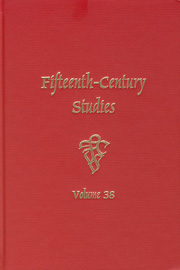Book contents
- Frontmatter
- Contents
- A Monastic Reformation of Domestic Space: Richard Whitford's Werke for Housholders
- Two Cultural Perspectives on the Battle of Lippa, Transylvania, 1551: Whose Victory Is It?
- Interpreting Sir Gawain and the Green Knight: Translation and Manipulation of Audience Expectations
- The Dry Tree Legend in Medieval Literature
- The Book of the Duke and Emperor: A New Edition and Interpretations within the Manuscript Context of MS. Manchester, Chetham's Library 8009 (Mun. A.6.31)
- Margery Kempe and the Spectatorship of Medieval Drama
- Wessel Gansfort, John Mombaer, and Medieval Technologies of the Self: Affective Meditation in a Fifteenth-Century Emotional Community
- Discerning Voices in the Trial of Joan of Arc and The Book of Margery Kempe
- Book Reviews
A Monastic Reformation of Domestic Space: Richard Whitford's Werke for Housholders
Published online by Cambridge University Press: 05 September 2013
- Frontmatter
- Contents
- A Monastic Reformation of Domestic Space: Richard Whitford's Werke for Housholders
- Two Cultural Perspectives on the Battle of Lippa, Transylvania, 1551: Whose Victory Is It?
- Interpreting Sir Gawain and the Green Knight: Translation and Manipulation of Audience Expectations
- The Dry Tree Legend in Medieval Literature
- The Book of the Duke and Emperor: A New Edition and Interpretations within the Manuscript Context of MS. Manchester, Chetham's Library 8009 (Mun. A.6.31)
- Margery Kempe and the Spectatorship of Medieval Drama
- Wessel Gansfort, John Mombaer, and Medieval Technologies of the Self: Affective Meditation in a Fifteenth-Century Emotional Community
- Discerning Voices in the Trial of Joan of Arc and The Book of Margery Kempe
- Book Reviews
Summary
Although neglected by scholars until quite recently, Richard Whitford, the self-styled “wretch” of Syon Abbey, was a widely-read author who not only participated in the ongoing transfer of monastic devotional culture to the laity through his writing but also actively engaged in defending this culture and its institutions against reformers. A onetime fellow of Queen's College, Cambridge, graduate of the University of Paris and associate of Erasmus and Thomas More, Whitford turned away from the prominent clerical and intellectual communities to which he belonged in the early sixteenth century to join the austere and spiritually élite Bridgettine community at Syon Abbey. However, Syon's high profile and comprehensive library ensured continual visitation from pious laypeople and devout scholars, and the abbey had a reputation for its commitment to the pastoral care of those residing in the precinct and visiting from afar. So, despite Whitford's apparent movement away from the affairs of the secular world, the brother's presence at Syon, which entailed strict enclosure from the world, necessitated regular interaction with individuals outside the cloister.
At a time when the ideals of the cloister were coming under increasing criticism, first from reformers and then from the crown, Whitford's regular contact with laypeople allowed him the opportunity to transmit elements of religious life outside of the monastery. In addition to preaching, the brother flourished as an author and translator during the period between his entrance into the abbey and Syon's expulsion in 1539.
- Type
- Chapter
- Information
- Fifteenth-Century Studies 38 , pp. 1 - 20Publisher: Boydell & BrewerPrint publication year: 2013



